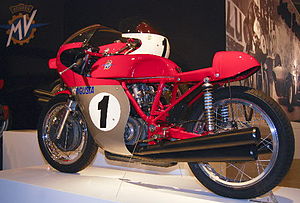MV Agusta 500 three-cylinder
| MV Agusta | |
|---|---|
 MV Agusta 500 three-cylinder, model 1972 |
|
| MV Agusta 500 three-cylinder | |
| Manufacturer | MV Agusta |
| Production period | 1965 to 1973 |
| class | Racing motorcycle |
| Motor data | |
| Four-stroke engine , air-cooled three-cylinder engine , DOHC with four valves hanging in the head operated by bucket tappets, oil sump lubrication, three Dell'Orto carburettors with a diameter of 30 mm, 8 volt battery ignition | |
| Displacement (cm³) | 497.9 |
| Power (kW / PS ) | 62.5 (85) at 12,000 min -1 (1972) |
| Top speed ( km / h) | 280 (1972) |
| transmission | 6/7 speed gearbox |
| drive | Chain |
| Brakes | front: double duplex drum brake 240 mm / rear: 230 mm drum brake |
| Wheelbase (mm) | 1.310 |
| Empty weight (kg) | 125 |
| Previous model | MV Agusta 500 four-cylinder (1952–1966) |
| successor | MV Agusta 500 four-cylinder |
The MV Agusta 500 three-cylinder (1965–1973) or MV Agusta Tre was a racing motorcycle from the Italian motorcycle manufacturer MV Agusta , which was used in the top class of the FIM for the motorcycle world championship . Giacomo Agostini won with this motorcycle from 1966 to 1972 the driver's world championship in the class up to 500 cm³ displacement; in addition, MV Agusta won the constructors' championships with this model from 1967 to 1972 . The MV Agusta Tre is considered the most successful racing motorcycle in history.
Development and technology
The air-cooled three-cylinder was the first MV Agusta engine with four-valve heads. The inlet valves have a diameter of 21 mm, the outlet valves 16.3 mm, the valve angle is 60 degrees. The valves are actuated by bucket tappets from two overhead camshafts , which are driven by a spur gear set on the right-hand side of the engine. The connecting rod pins of the crankshaft are offset by 120 degrees; two of the six roller bearings are located at the end of the crankshaft. Having only an L-shaped oil control ring on the piston was unusual for a four-stroke engine. Three 30 mm Dell'orto - carburetor supplying the engine with fuel mixture is ignited with 10 mm Marelli - spark plugs which receive their power from an 8-volt battery ignition.
Races
Already the first use of a Tre (but with 350 cm³ displacement and in this class) at the first round of the World Championship for the Motorcycle World Championship in 1965 on the Nürburgring was a complete success. The young Giacomo Agostini won confidently ahead of the old master Mike Hailwood . In the second run of the 1966 season, Agostini drove a 420 Tre in the 500 class for the first time, and only in the seventh run did the Tre drilled to 500 cm³. Up until the 1967 season , Mike Hailwood was the toughest contender for the world championship on a Honda . However, after Honda had withdrawn from racing at the end of 1967, there was no comparable racing team that MV Agusta could have contested the title in the 500cc class; it stayed that way until the 1972 motorcycle world championship . The first races of the 1973 season were driven by Agostini on his Tre , after which it was replaced by the more powerful MV Agusta 500 four-cylinder . The 1973 Tre received disc brakes from Scarab as a modification at the front , but in terms of performance it was inferior to the two-stroke models from Yamaha .
Sister model
The MV Agusta 350 Tre, which was developed before the 500, was no less successful. From 1968 to 1973 Giacomo Agostini was world champion driver with this model in the class up to 350 cc. For the 1974 motorcycle world championship , MV Agusta did not compete in the 350 cm³ class, MV Agusta concentrated on winning the half-liter class. Technically, both machines were almost identical. In order to achieve the smaller displacement, the 350 Tre had a 52 mm bore, a smaller tank, generally a seven-speed gearbox and weighed about 3 kg less. The performance of the 350 (1972) was 65 horsepower at 13,500 min -1 revolutions.
References
literature
- Mario Colombo, Roberto Patrignani: MV Agusta . Motorbuch Verlag. Stuttgart 2000, ISBN 3-613-01416-5 .
- Siegfried Rauch: Famous racing motorcycles. 2nd Edition. Motorbuch Verlag, Stuttgart 1980, ISBN 3-87943-590-1 .
- Christian Spahn: MV Agusta . Technology and history of racing motorcycles. 1st edition. Serag-Verlag, 1986, ISBN 3-908007-13-1 .
Web links
- Agostini starts the Tre (youtube)
Individual evidence
- ↑ MV Agusta Club.de (accessed on September 30, 2011)
- ^ Colombo, Patrignani: MV Agusta . 2000, p. 246
- ^ Spahn: MV Agusta. 1986, p. 195 ff.
- ^ Colombo, Patrignani: MV Agusta . 2000, p. 244


